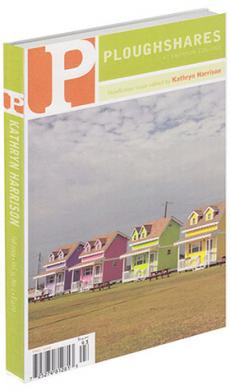Rev. of Irish Elegies by Chris Arthur
Irish Elegies, personal essays by Chris Arthur (Palgrave-Macmillan): Irish Elegies is Chris Arthur’s fourth book of new essays in a series that includes Irish Nocturnes (1999), Irish Willow (2002), and Irish Haiku (2005), all published by the Davies Group, all fondly recommended by this reviewer. Irish Elegies departs from the trilogy by joining the ranks of Palgrave-Macmillan’s New Directions in Irish and Irish American Literature series, which has thus far consisted of academic studies of primary sources. So congratulations (and thanks) are in order for the publisher. ‘Tis much more valuable and interesting to contribute to the literature of a place than to criticize it (as I am doing).
I first encountered Chris Arthur through The Southwest Review, which published his essay "Room, Empty," in 2006. I was immediately taken with the piece, which within its first two pages never really gets beyond questioning the choices of a few words in the first couple of sentences; through the rest of its twenty-some pages, the essay ruminates presence and absence and belonging, all through the lens of an empty room. Brilliant! I thought, as I had already soured on the vainglorying of sensationalist memoirists and loved the mind-journeys of long-dead essayists. Chris Arthur was heir to the latter tribe’s tenets. I tracked down Arthur’s published books and checked the journals for more of his masterful essays. Two-thousand-eight brought another favorite of mine (and of this year’s Best American Essays editor, Mary Oliver), "(En)trance," from The Literary Review. This essay, too, perambulates and meditates on the author’s childhood haunts, with no drama or wider history than the ruminations on great complexities inherent even in small, local, mundane things.
Indeed, this focus on the quotidian is utterly central to Chris Arthur’s writing, which is as it should be. Thus "(En)trance," which begins Irish Elegies, is a quintessential essay. It launches, meta-literarily, from the pillars at Shandon, Arthur’s mother’s childhood home in Northern Ireland, and never really leaves them, never gets past the gate and into the yard, let alone the house beyond. Throughout, Arthur compares himself to another kind of writer (of fiction/suspense/drama) with humility and self-deprecation, noting how far ahead the "writer of the sort [he’s] not" would be at this point in the prose, etc. Ultimately, Arthur is simply an essayist, concerned with detail and the wonder of memory, warning that "the grownup mind too easily falls for the lure of the superficial, the simple, the no-nonsense, the cut-and-dried, and lazily equates what meets the eye with truth." For the sake of perspective, he casts his imagination into a "temporal kestrel," hovering above the pillars, whisking to the past and future, imagining the changes as time obliterates one thing after another. In the end, "(En)trance" is unsummarizable (another hallmark of real essays), though it may certainly be said to fulfill Arthur’s partial ideal: "Essays occupy the margins, explore liminal spaces, turn back upon themselves, deal with seemingly ordinary things, tolerate meandering and incompletion, estrange the familiar."
Throughout the collection, Arthur shows that he is "in love with this green earth" (Lamb); despite his assurances that he, like us, lives most of his life in a fog of routine and familiarity, he is quite adept at finding surprise in the everyday, insignificant details of experience. He takes disparate pieces of memory and experience to investigate his and others’ stories, weaving meaning (potential, not definitive) and understanding of life. He incessantly fiddles with the intricacies of memory, understanding that things change their "valency" when we remember them, that some memories seem accidental, and that writing changes the "texture" of the original experience.
In "Thirty-six Views, None of Mount Fuji," for instance, Arthur models his writing on Hokusai’s drawings, offering three dozen images/vignettes of the home he grew up in, beginning with the large maple tree out front. But the author cannot even stick to his own constraints. For one, he soon turns meta-essayistic, troubling the very concept of a "view," and wondering at the dizzying complexities inherent in any attempt to fix a thing in language; for another, he offers a bonus view (in the spirit of Hokusai, who also went beyond his stated number of drawings), and he does allow a bit of Mount Fuji. These latter violations are certainly artistically contrived, but the former grows organically from the character of the writer, which is a joy for me to witness. I’m reading not only the finished product of a genius (an appellation Arthur disavows), but I’m seeing his process as well.
To return to an idea I’ve brought up already: Irish Elegies is beautifully short on cheap thrills and fantastic flips, but it’s long on profound thinking driven by ordinary experience, the type of stuff that’s surrounding us everywhere, all the time. Thus Chris Arthur writes not only from pillars and maples but from his neighbor’s rose garden; a photograph of his mother, age five; his father’s book collection; an obscure superficial greeting; broken flagstone paths; the combination furnace/stove that heated his home and cooked his meals; the question of whether we fall asleep on an in-breath or an out-breath. Who could know that these apparently inane subjects could spark such reverie? Yet they do, because Arthur is a master essayist, adept at bringing his whole brain to bear on meaning-making.
In "Object Lesson on Qualia, with No Mention of the Term," he takes a pair of imaginative journeys, first into the life of a familiar stranger, whom he sees daily walking by, and second into the history of a Chinese cloisonné bowl, which the stranger sold to his mother years ago. Connecting his two subjects beyond their temporal-spatial overlap, he wonders "How did this object—how does any object—mesh into the particularity of someone else’s outlook; how is it read by the perceptions—feelings—thoughts—memories that constitute the fabric of another mind?" He recognizes (or declares) that the bowl, and other objects like it, "act like tuning forks, reminding us that beyond whatever mundane song we sing there is the gargantuan note of the infinite humming beneath it, that we are all part of a story spanning enormous stretches of time and space; that however imprisoned we may feel locked within the cloison-cells of our particular life-worlds, we are embedded in stupendous connections."
The stupendous connection is the lifeblood of Irish Elegies, its electricity, its animating spirit. As I came to the end of the book, I felt as if I had been sitting at the feet of a master, learning the ways of observation and meditation, as if I had been endowed with a new power for seeing beauty in everything around me, infused with the spirit of the essay. —Patrick Madden teaches creative writing at Brigham Young University. His essay collection, Quotidiana, will be published in 2010 by the University of Nebraska Press.

